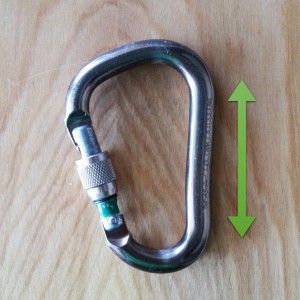Why Belaying Off Your Hard Points is a Bad Idea
-Blog post written by Abree Murch
Have you ever wondered why we don’t belay off the same points we tie into when we climb? It has to do with the physics of a piece of gear you might not expect: your locking carabiner.
While it may seem like more points of contact on the carabiner would make belaying safer, it’s actually quite the opposite. Carabiners are engineered to be loaded along their spine, with a single force acting in each direction. Take a look at the strength ratings on the side of your typical locking carabiner – most are over 3x stronger along their spine (the major axis) than along any other axis.
If a belayer clips their locking biner into their harness’s hard points and then adds a belay device, they create what’s known as a tri-axial load, meaning they have forces acting in three different directions on the biner. Furthermore, one of these forces is pulling on a point that’s out of line with the spine of the biner. Black Diamond conducted testing on HMS style carabiners in tri-axial loading scenarios and found that the configuration reduced the strength of the carabiner by about 20%. BD also took it one step further and tested a quad-axial loading scenario and found that four loads reduced the strength of the biner by about 25%. Check out the full report from BD’s QC Lab here.
So keep belaying off those belay loops! To be certified by the UIAA, the belay loop on your harness must withstand 15 kN of force (that’s over 3300 lbs) for three minutes, so it’s plenty strong. It might be counterintuitive, but in the case of the number of loads on your locking carabiner, less is more.








